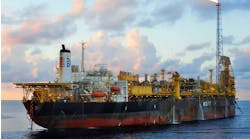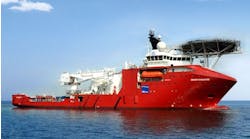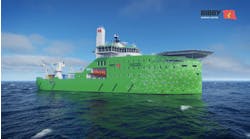AGR Group, Helix Energy Solutions undertake FPSO conversion
In 1Q 2007, AGR Group and Helix Energy Solutions Group Inc. jointly acquired a fuel supply vessel from the Australian Commonwealth government. The group plans to convert theWestralia, previously used by the Royal Australian Navy, into an FPSO.
The FPSO, to be renamedShiraz, will be marketed throughout Southeast Asia as an early production system or extended production test vessel, the companies say. Operators will be able to use this FPSO in the short term to evaluate the longer-term production potential of their fields and to reduce dependence on appraisal drilling in the currently tight rig market.
TheShiraz FPSO will allow operators with limited financial capacity to realize early cash flows from their assets at a cost that is a fraction of competing systems, the companies say.
TSMarine invests in decommissioning, intervention vessels
Aberdeen-based TSMarine is investing $253 million in two specialized vessels in a bid to move into the subsea decommissioning and rigless well intervention markets.
TSMarine says the vessels will be uniquely equipped with specially designed well abandonment and intervention support packages. This equipment will include a module-handling tower, subsea intervention lubricator to allow access for subsea well intervention and decommissioning activities, and inbuilt workclass ROV systems.
TSMarine is investing $253 million in two specialized vessels in a bid to move into the subsea decommissioning and rigless well intervention markets.
According to TSMarine, the objective in investing in these newbuilds is to exploit the burgeoning subsea decommissioning and rigless intervention market, where global expenditure is forecast to rise by 170% in the next eight years, according to subsea oil and gas analysts, Infield Systems Ltd. The global value of this sector in 2009 is expected to be $972 million.
The vessels are designed by Norwegian naval architects Marin Teknikk and are of the MT6040 type. They will be built at the Astilleros Huelva shipyard in Spain.
Labroy Marine fills its order book
Late last year, Singapore’s Labroy Marine Ltd. struck steel for a new jackup being built for Standard Drilling ASA.
The L 201 MSC Gusto CJ 46-X100D design rig is an independent leg cantilever jackup with water depth capability of 107 m (350 ft) and a drilling depth capability of 9,144 m (30,000 ft).
ABS will classify the vessel, which is the first of its kind in Indonesia, according to Ravi Chadha, Indonesia country manager for ABS. Chadha’s team of surveyors will oversee jackup construction to verify the rig is built in accordance with ABS Rules.
Delivery is scheduled for September 2008.
The company started 2007 with an order book sitting at $1.06 billion. Deliveries include four jackup rigs, scheduled through to 2009.
Work on the first two of the four jackups started at the new Batam shipyard, with first steel strike scheduled for the other two for May/June this year, Labroy says.
In March last year, Labroy signed the first jackup contracts to build two units worth $310.7 million for Standard Drilling, followed by two additional jackup contracts, worth $317.24 million, in October. The rest of the orders are for oilfield related vessels, including AHTSs.
Labroy is in the midst of investing the second $9.81 million of the $16.35 million budget to build a new shipyard on Indonesia’s Batam Island. Labroy Managing Director Tan Boy Tee says the new yard is being readied to handle up to 12 jackup projects. Facilities and space are ready for nine jackups, he says.
COSCO wins its first semisubmersible contract
Early this year, Cosco Shipyard Group signed a letter of intent with Marine Accurate Well ASA to build a GM4000 semisubmersible for well intervention services.
The GM4000 is designed for intervention services including through-tubing drilling and coiled tubing drilling. Maracc says it will be the first purpose-built unit capable of year-round operations on the Norwegian continental shelf.
The contract, valued at $200 million, includes an option for three more new vessels. Maracc believes industry indicators support investment in newbuilds.
COSL breaks new ground
In late December 2006, China Oilfield Services Ltd. signed agreements with Goimar SA de CV, an oilfield service company serving the Gulf of Mexico. COSL will supply four module rigs to operate in the Gulf.
COSL will build the four rigs and will mobilize them to the work site, where the company will perform installation and rig-up. Each rig will be employed for a three-year term. Construction is expected to be completed in 2Q 2007.
In early January 2007,COSL4, the first 7,000-m (22,966-ft) module rig designed, constructed, installed, and mobilized in China, departed Nantong for its work site in the GoM. The COSL4 rig is the first of the four module rigs COSL is building for use by Pemex.
COSL owns the intellectual property rights for all four module rigs, of which 92% of the key equipment and systems were made in China.
In February, COSL and Atlantis Deepwater Technology Holding AS established a joint-venture to develop a new concept.
Atlantis Deepwater Orient Ltd. will develop the “Atlantis” concept aimed at allowing third-generation semisubmersibles to operate in deepwater. Equipment upgrades and functional testing are under way, according to COSL.
“The industry development and the demands from clients are why COSL is working hard on exploring in deepwater drilling techniques,” says Yuan Guangyu, CEO and president. “The establishment of joint venture with ADTH is one of the important steps to explore advanced deepwater oil drilling techniques. The successful exploration of the Atlantis concept will greatly enhance COSL’s deepwater drilling capability to about 1,500 m (4,921 ft).”
ASRY completes jackup refurbishment
The Arab Shipbuilding and Repair Yard in Bahrain recently completed a jackup refurbishment for Abu Dhabi’s National Drilling Co.
ASRY carried out $13 million in upgrades on the self-elevating three-legged jackup drilling rigAl Mariyah.
The rig arrived in Bahrain on June 10, 2006, for a six-month refurbishment and upgrade program. ASRY carried out repairs and partial renewal to the three cylindrical legs and overhauled the leg elevating system. Repairs included installing a new raw water tower, fabricating new lifeboat platforms and replacing a substantial amount of steel. ASRY also refurbished the accommodation quarters and other common areas, and blasted and painted the topsides.




